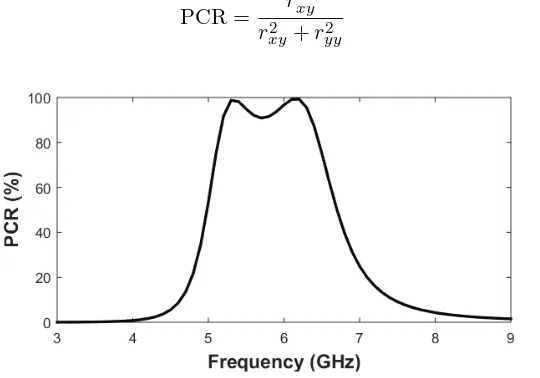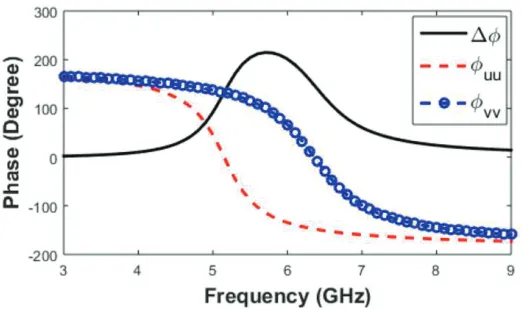Abstract—In the recently published article, Sood and Tripathi (Progress In Electromagnetics Research
M, Vol. 44, 39–46, 2015) proposed a wide-angle ultra-thin metamaterial absorber structure for wideband applications. The reported unit cell was shown to have simulated wideband absorptivity FWHM bandwidth of 1.94 GHz, i.e., from 5.05 GHz to 6.99 GHz. In this article, we prove that the reported structure is not an electromagnetic wave absorber. For the reported structure, we find that absorption is less than 22.3% over a operating bandwidth of 4 GHz to 8 GHz. It is demonstrated that the strong absorption was caused due to ignorance of cross-polarization effect rather than true absorption as they claimed.
1. INTRODUCTION
In recent times, planar electromagnetic metamaterial absorbers have gained a lot of attention from researchers after Landy et al. published the first paper [1]. Near unity absorption was realized using electric LC resonators and cut-wires separated by dielectric spacer. Nowadays, several works related to a metamaterial absorber have been published at microwave and THz frequency regime. With further developments, research in this area includes achieving near unity absorption characteristics for multi-band, broadband frequencies maintaining polarization insensitive and ultra-thin profile. There are articles which report broadband absorption phenomenon [2–6]. However, on further investigations, it was found that the broadband absorption resulted from ignorance of cross-polarized reflections from the structures. This fact is addressed by the articles respectively [7–11]. In subsequent section, study and investigations are carried out on the structure proposed in [12], and it is shown that already reported structure is not a metamaterial absorber.
2. NUMERICAL SIMULATION, RESULTS AND DISCUSSIONS
Recently, Sood et al. published an article on a wide-angle ultra-thin, wideband metamaterial absorber structure [12]. The presented structure had four circular slots etched from 45◦ inclined hexagonal metal patch as shown in Fig. 1. The proposed design was printed on an FR-4 substrate (εr = 4.4 and tanδ = 0.02). The other face of the substrate was made of complete copper for zero transmission. The authors reported that for the proposed structure absorptivity has FWHM bandwidth of 1.94 GHz, i.e., from 5.05 GHz to 6.99 GHz. The structure was simulated in full wave electromagnetic solver Ansys HFSS using periodic boundary conditions and Floquete port excitation. The absorption peaks for the structure were reported at 5.34 GHz, 6.33 GHz with absorption rates of 99.20% and 99.62%, respectively. We again resimulated the structure using Ansys HFSS to understand wide-band absorption phenomenon. The details of geometrical and structural parameters are the same as mentioned by Sood et
Received 23 November 2017, Accepted 12 February 2018, Scheduled 8 March 2018
* Corresponding author: Dushyant Marathe (dushyantmarathe@gmail.com).
Figure 1. Top view of the reported unit cell [12].
Figure 2. Numerically simulated co-polarized (ryy) and cross-polarized (rxy) reflections under normally incidenty-polarized (TE) electromagnetic wave.
Figure 3. Numerically simulated absorption spectra under normally incident y-polarized (TE) electromagnetic wave.
low value of co-polarized reflectance and high value (>0.75) of cross-polarized reflectance support our claim. It implies that the major portion of the wave is reflected as cross-polarized reflectance. Original authors fabricated a prototype structure and presented measurement results showing close agreement with near unity absorption. However, measurements might have done only for co-polarized reflections. To measure cross-polarized reflections, receiving horn antenna has to be rotated by 90◦ with respective to transmitting horn.
The polarization conversion ratio (PCR) can be obtained from co-polarized and cross-polarized reflectances as given below. PCR computed using Eq. (2) as shown in Fig. 4 has conversion efficiency more than 90% from 5.2 GHz to 6.4 GHz. The structure can be served as a wideband high efficiency polarization converter [13].
PCR = r
2
xy
r2
xy +ryy2 (2)
Figure 4. Numerically simulated results of polarization conversion ratio (PCR) for normally incident
y-polarized electromagnetic wave.
(a) (b)
Figure 5. (a) Co-ordinate rotation and (b) polarization rotation.
Figure 6. Numerically simulated reflection magnitude for decomposed u-polarized and v-polarized incident electromagnetic wave.
Figure 7. Numerically simulated reflection phases (φuu, φvv), phase difference (Δφ= φvv−φuu) for
absorber,” Phys. Rev. Lett., Vol. 100, 207402, 2008.
2. Yoo, Y. J., Y. J. Kim, J. S. Hwang, J. Y. Rhee, K. W. Kim, Y. H. Kim, H. Cheong, L. Y. Chen, and Y. P. Lee, “Triple-band perfect metamaterial absorption, based on single cut-wire bar,”Appl.
Phys. Lett., Vol. 106, 071105, 2015.
3. Khuyen, B. X., B. S. Tung, N. V. Dung, Y. J. Yoo, Y. J. Kim, K. W. Kim, V. D. Lam, J. G. Yang, and Y. Lee, “Size-efficient metamaterial absorber at low frequencies: Design, fabrication, and characterization,” J. Appl. Phys., Vol. 117, 243105, 2015.
4. Agarwal, M., A. K. Behera, and M. K. Meshram, “Dual resonating C-band with enhanced bandwidth and broad X-band metamaterial absorber,”Appl. Phys. A, Vol. 122, 166, 2016.
5. Bhattacharyya, S., S. Ghosh, D. Chaurasiya, and K. Srivastava, “Wideangle broadband microwave metamaterial absorber with octave bandwidth,”IET Microwaves, Antennas Propag., Vol. 9, 1160– 1166, 2015.
6. Sood, D. and C. C. Tripathi, “A wideband ultrathin low profile metamaterial microwave absorber,”
Microw. Opt. Technol. Lett., Vol. 57, 2723–2728, 2015.
7. Yin, S., J. Zhu, W. Jiang, J. Yuan, G. Yin, and Y. Ma, “Comment on “Triple-band perfect metamaterial absorption, based on single cut-wire bar [Appl. Phys. Lett., Vol. 106, 071105, 2015],””
Appl. Phys. Lett., Vol. 107, 026101, 2015.
8. Liu, L., S. Liu, H. Zhang, X. Kong, H. Yang, G. Ding, C. Xu, L. Wang, and W. Shi, “Comment on “Size-efficient metamaterial absorber at low frequencies: Design, fabrication, and characterization [J. Appl. Phys., Vol. 117, 243105, 2015],”” J. Appl. Phys., Vol. 119, 226101, 2016.
9. Li, B., Q. Chen, Y. Fu, et al., “Comment on “Dual resonating C-band with enhanced bandwidth and broad X-band metamaterial absorber,”” Appl. Phys. A, Vol. 122, 166, 2016.
10. Kundu, D., A. Mohan, and A. Chakraborty, “Comment on “Wide-angle broadband microwave metamaterial absorber with octave bandwidth,””IET Microwaves, Antennas Propag., Sep. 2016. 11. Tian, D., H. Shi, and A. Zhang, “Comment on “A wideband ultrathin low profile metamaterial
microwave absorber,””Microw. Opt. Technol. Lett., Vol. 58, 1773–1774, 2016.
12. Sood, D. and C. C. Tripathi, “A wideband wide-angle ultra-thin metamaterial microwave absorber,”
Progress In Electromagnetics Research M, Vol. 44, 39–46, 2015
![Figure 1. Top view of the reported unit cell [12].](https://thumb-us.123doks.com/thumbv2/123dok_us/1977467.1261164/2.612.178.436.458.603/figure-view-reported-unit-cell.webp)

